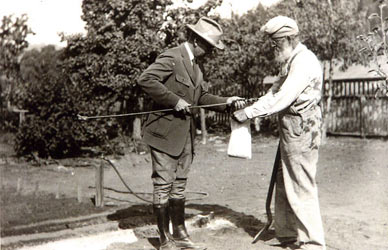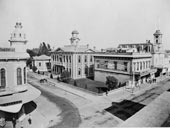
Santa Cruz, California
Levi Starbuck’s Cork Oak Tree 
(left) Downtown Santa Cruz, circa 1900. Courtesy Library of Congress. (right) Henry Washburn, 1917. Courtesy Washburn Collection of the Agricultural History Project, Watsonville, CA.
history continued
As the Cork Oak predates his purchase of the land by several years, it is likely that Starbuck transplanted it from another location, possibly Los Angeles County where he and his wife are listed on the 1880 census. In 1904, due to their failing health, the Starbucks sold the house and moved to a smaller property in downtown Santa Cruz. Years later, the preceding owner noted that when her family purchased the house, the driveway wound through extensive gardens and large trees.
The Cork Oak, located on a heavily trafficked street corner in what is now a commercial area, is one of the only remaining plants from Starbuck’s original garden. Henry Washburn, Santa Cruz County Farm Advisor from 1917 to 1955, carefully documented the county’s agricultural history throughout his service. In 1939, he photographed the Cork Oak and wrote in his annual report to the US Department of Agriculture that a stripping and growth test would be conducted on the tree. While the original annual reports contain no record of this, the photograph and the property owner's written consent to allow the tests remain. A newspaper account confirms that Dr. Woodbridge Metcalf, a retired forestry expert with the University of California Agricultural Extension Service in Berkeley, California, did strip the tree of its bark sometime in the 1940s.
